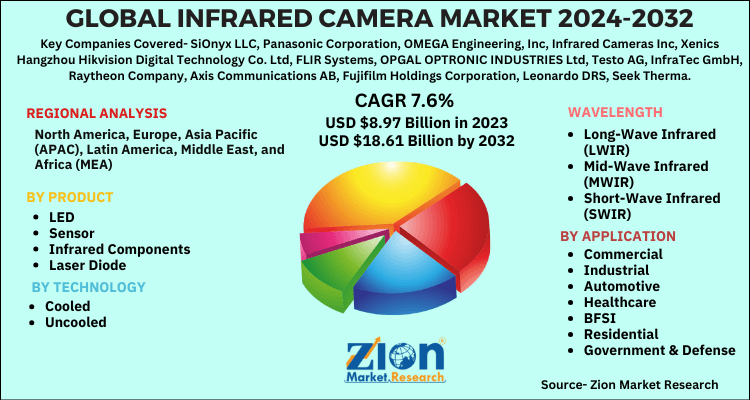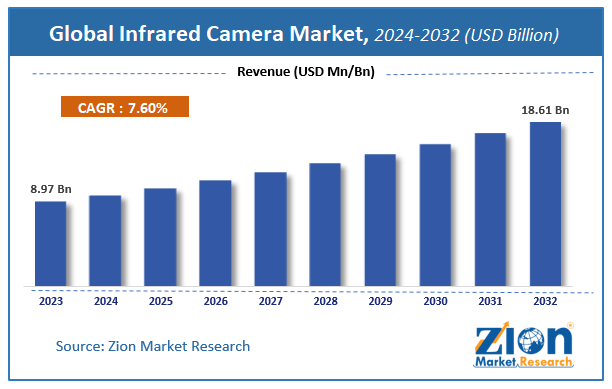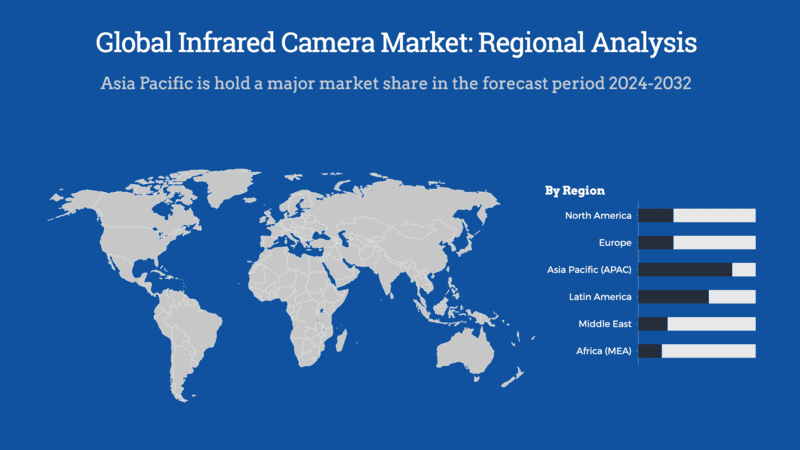Infrared Camera Market Size, Share, Trends, Growth and Forecast 2032

Infrared Camera Market - By Product [Handheld, Fixed, and Pan-Tilt-Zoom (PTZ)], By Technology (Cooled and Uncooled), By Wavelength [Long-Wave Infrared (LWIR), Mid-Wave Infrared (MWIR), Short-Wave Infrared (SWIR), and Near Infrared (NIR)], By Application (Commercial, Industrial, Automotive, Healthcare, BFSI, Residential, Government & Defense, and Others), and By Region: Global Industry Perspective, Market Size, Statistical Research, Market Intelligence, Comprehensive Analysis, Historical Trends, and Forecasts, 2024-2032
| Market Size in 2023 | Market Forecast in 2032 | CAGR (in %) | Base Year |
|---|---|---|---|
| USD 8.97 Billion | USD 18.61 Billion | 7.6% | 2023 |
Infrared Camera Market Insights
According to Zion Market Research, the global Infrared Camera Market was worth USD 8.97 Billion in 2023. The market is forecast to reach USD 18.61 Billion by 2032, growing at a compound annual growth rate (CAGR) of 7.6% during the forecast period 2024-2032. The report offers a comprehensive analysis of the market, highlighting the factors that will determine growth, potential challenges, and opportunities that could emerge in the Infrared Camera industry over the next decade.
Infrared Camera Market Overview
The SWIR category under the wavelength segment witnesses remarkable growth in the coming years owing to the extensive utilization of IR-based technology in the industrial vertical. SWIR cameras have a wide array of applications in spectroscopy, semiconductor analysis, surveillance, scientific research, moisture detection, and high-temperature thermography, among others. SWIR camera manufacturers are continuously investing in and incorporating novel technologies to develop reasonably priced cameras.
The Asia Pacific infrared camera market is projected to escalate furiously in the coming years owing to the constant product development efforts and rising demand for the product by the regional developing economies such as India, Japan, and China.
Key Insights
- As per the analysis shared by our research analyst, the global infrared camera market is estimated to grow annually at a CAGR of around 7.6% over the forecast period (2024-2032).
- In terms of revenue, the global infrared camera market size was valued at around USD 8.97 billion in 2023 and is projected to reach USD 18.61 billion by 2032.
- Based on the product type, Fixed Infrared Cameras this segment dominates the global market, accounting for approximately 48% of the share in 2024
- Based on Technology, Uncooled Infrared Cameras this uncooled segment leads the market.
- Based on Wavelength, the Long-Wave Infrared (LWIR) this LWIR segment holds a significant market share, LWIR cameras are primarily used for temperature testing and measurement applications across various industries, excelling in accurately measuring surface temperature profiles even at considerable distances or in complete darkness.
- Based on Application, the Government & Defense, This segment dominates the market, holding a 40% share in 2020. Infrared cameras are extensively used in border security and coastline surveillance to secure nations.
- Based on region, Asia-Pacific: In 2020, Asia-Pacific held the maximum share in the global infrared camera market. Factors such as increasing production of smart electronics, rising terror attacks, and government spending on defense equipment drive the market in this region.
Infrared Camera Market: Dynamics
Key Growth Drivers
The anesthesia machinery market is driven by the rising number of surgical procedures worldwide, fueled by an aging population and an increasing prevalence of chronic diseases that require surgical interventions. Technological advancements, such as the integration of artificial intelligence (AI) and automation in anesthesia machines, enhance patient safety and operational efficiency, further boosting market growth. Additionally, the growing demand for outpatient and ambulatory surgical centers, which require cost-effective and portable anesthesia systems, contributes to the expansion of the market. The rise in healthcare expenditure and government initiatives to improve surgical care facilities also play a significant role in driving demand for advanced anesthesia machinery.
Restraints
Despite the positive outlook, the anesthesia machinery market faces several restraints, including the high cost of advanced anesthesia machines and the associated maintenance expenses. The requirement for skilled professionals to operate these machines effectively can also limit their adoption, particularly in developing regions with a shortage of trained anesthesiologists. Stringent regulatory requirements and lengthy approval processes for new anesthesia equipment pose another challenge for manufacturers, delaying product launches and market entry. Additionally, concerns over equipment malfunctions and the potential risks associated with anesthesia administration may hinder market growth.
Opportunities
The growing focus on healthcare infrastructure development in emerging economies presents significant opportunities for the anesthesia machinery market. Countries in Asia-Pacific and Latin America are investing in modernizing hospitals and surgical facilities, increasing the demand for anesthesia machines. The rising adoption of minimally invasive surgeries, which require precise anesthesia delivery, also creates opportunities for market expansion. Furthermore, the development of portable and wireless anesthesia machines opens new avenues for use in ambulatory care and remote medical settings. Advancements in patient monitoring technology and the integration of electronic health records (EHRs) with anesthesia machines further enhance market potential.
Challenges
One of the major challenges in the anesthesia machinery market is the risk of device-related complications and safety concerns, which can lead to product recalls and legal issues for manufacturers. The lack of uniformity in healthcare standards and infrastructure across different regions makes it difficult for companies to establish a global footprint. Economic fluctuations and budget constraints in healthcare institutions can also slow down the adoption of advanced anesthesia machinery. Additionally, the growing emphasis on alternative pain management techniques, such as regional anesthesia and conscious sedation, may reduce the reliance on traditional anesthesia machines in some cases, posing a challenge to market growth.
Infrared Camera Market: Report Scope
| Report Attributes | Report Details |
|---|---|
| Report Name | Infrared Camera Market |
| Market Size in 2023 | USD 8.97 Billion |
| Market Forecast in 2032 | USD 18.61 Billion |
| Growth Rate | CAGR of 7.6% |
| Number of Pages | 110 |
| Key Companies Covered | SiOnyx LLC, Panasonic Corporation, OMEGA Engineering, Inc, Infrared Cameras Inc, Xenics Hangzhou Hikvision Digital Technology Co. Ltd, FLIR Systems, OPGAL OPTRONIC INDUSTRIES Ltd, Testo AG, InfraTec GmbH, Raytheon Company, Axis Communications AB, Fujifilm Holdings Corporation, Leonardo DRS, Seek Therma, Honeywell International Inc, DIAS Infrared GmbH, Optris GmbH, Fluke Corporation, and Hanwha Techwin Co. Ltd |
| Segments Covered | By Product, By Technology, By Wavelength, By Application, By Region |
| Regions Covered | North America, Europe, Asia Pacific (APAC), Latin America, Middle East, and Africa (MEA) |
| Base Year | 2023 |
| Historical Year | 2018 to 2022 |
| Forecast Year | 2024 - 2032 |
| Customization Scope | Avail customized purchase options to meet your exact research needs. Request For Customization |
Global Infrared Camera Market: Segmentation
 Request Free Sample
Request Free Sample
The research study provides a decisive view of the global infrared camera market based on product, technology, wavelength, application, and region. All the segments of the market have been analyzed based on past, present, and future trends. The market is estimated from 2024 to 2032.
By product, the global market is bifurcated into a handheld, fixed, and pan-tilt-zoom (PTZ).
Based on technology, the market is categorized into cooled and uncooled.
based on Wavelength-wise, the global market is divided into long-wave infrared (LWIR), mid-wave infrared (MWIR), short-wave infrared (SWIR), and near-infrared (NIR).
By application, the infrared camera industry is classified into commercial, industrial, automotive, healthcare, BFSI, residential, government & defense, and others.
The regional segmentation comprises the past, present, and estimated demand for the Middle East & Africa, North America, Asia Pacific, Latin America, and Europe. The regional segment is further split into the U.S., Canada, Mexico, UK, France, Germany, China, Japan, India, South Korea, Brazil, and Argentina among others.
Global Infrared Camera Market: Regional Analysis
The infrared camera market exhibits notable regional variations, influenced by factors such as industrial growth, technological advancements, and sector-specific demands.
North America
North America stands as a significant market for infrared cameras, propelled by a robust industrial base and technological innovations. Key applications span defense, aerospace, and automotive sectors, with the United States and Canada being major contributors. The region's focus on technological innovation and the integration of AI and IoT in infrared camera solutions are expected to sustain market growth. The increasing use of infrared cameras in industries such as automotive, aerospace, and defense for applications like night vision and target acquisition further solidifies North America's market position.
Asia-Pacific
The Asia-Pacific region is poised to be a significant growth driver for the infrared camera market, with a projected CAGR of 9.2% from 2024 to 2032. This growth is fueled by rapid industrialization, urbanization, and increasing infrastructure investments in countries such as China, India, and Japan. The region's burgeoning manufacturing sector and the growing adoption of surveillance technologies in smart city projects are expected to drive demand for infrared cameras. Additionally, the emphasis on energy efficiency and renewable energy solutions in the region aligns with the expanding applications of infrared technology in thermography and energy audits, further supporting market growth.
Europe
Europe, with its emphasis on energy efficiency and stringent regulatory frameworks, is a significant market for infrared cameras in applications such as building inspections and industrial monitoring. The region's commitment to sustainability and green building initiatives is driving the adoption of infrared technology for energy audits and efficiency optimization. Moreover, the aerospace and defense sectors in Europe are increasingly utilizing infrared cameras for surveillance and reconnaissance operations. As European countries continue to invest in smart cities and enhance security measures, the demand for infrared cameras is expected to grow, supported by advancements in technology and the increasing availability of cost-effective solutions.
Rest of the World
Regions such as Latin America, the Middle East, and Africa are witnessing increasing adoption of infrared cameras across various applications, particularly in oil and gas facilities, border security, and industrial monitoring. The market growth is supported by rising investments in infrastructure development, increasing security concerns, and growing industrial applications. The adoption of infrared cameras in customs and border control applications, particularly in the Middle East, demonstrates the expanding use cases for this technology.
In summary, the infrared camera market is experiencing diverse growth patterns across regions, driven by specific industrial needs, technological advancements, and regulatory environments.
Global Infrared Camera Market: Competitive Players
Some of the essential players flourishing the global infrared camera market, but not restricted to include -
- SiOnyx LLC
- Panasonic Corporation
- OMEGA Engineering
- Infrared Cameras Inc.
- Xenics Hangzhou Hikvision Digital Technology Co. Ltd.
- FLIR Systems
- OPGAL OPTRONIC INDUSTRIES LTD.
- Testo AG
- InfraTec GmbH
- Raytheon Company
- Axis Communications AB
- Fujifilm Holdings Corporation
- Leonardo DRS
- Seek Therma
- Honeywell International Inc.
- DIAS Infrared GmbH
- Optris GmbH
- Fluke Corporation
- Hanwha Techwin Co. Ltd.
The global infrared camera market is segmented as:
Global Infrared camera Market: Product Segmentation Analysis
- Handheld
- Fixed
- Pan-Tilt-Zoom (PTZ)
Global Infrared camera Market: Technology Segmentation Analysis
- Cooled
- Uncooled
Global Infrared camera Market: Wavelength Segmentation Analysis
- Long-Wave Infrared (LWIR)
- Mid-Wave Infrared (MWIR)
- Short-Wave Infrared (SWIR)
- Near-Infrared (NIR)
Global Infrared camera Market: Application Segmentation Analysis
- Commercial
- Industrial
- Automotive
- Healthcare
- BFSI
- Residential
- Government & Defense
- Others
Global Infrared camera Market: Regional Segmentation Analysis
- North America
- The U.S.
- Canada
- Europe
- France
- The UK
- Spain
- Germany
- Italy
- Rest of Europe
- Asia Pacific
- China
- Japan
- India
- South Korea
- Southeast Asia
- Rest of Asia Pacific
- Latin America
- Brazil
- Mexico
- Rest of Latin America
- Middle East & Africa
- GCC
- South Africa
- Rest of Middle East & Africa
Table Of Content
Methodology
FrequentlyAsked Questions
. The market is forecast to reach USD 18.61 Billion by 2032
global Infrared Camera Market was worth USD 8.97 Billion in 2023
growing at a compound annual growth rate (CAGR) of 7.6% during the forecast period 2024-2032.
The global infrared camera market is segmented based on product, technology, wavelength, application, and region. By product, the global market is bifurcated into a handheld, fixed, and pan-tilt-zoom (PTZ). Based on technology, the market is categorized into cooled and uncooled. Wavelength-wise, the global market is divided into long-wave infrared (LWIR), mid-wave infrared (MWIR), short-wave infrared (SWIR), and near-infrared (NIR). By application, the infrared camera industry is classified into commercial, industrial, automotive, healthcare, BFSI, residential, government & defense, and others.
SiOnyx LLC, Panasonic Corporation, OMEGA Engineering, Inc., Infrared Cameras Inc., Xenics Hangzhou Hikvision Digital Technology Co. Ltd., FLIR Systems, OPGAL OPTRONIC INDUSTRIES LTD., Testo AG, InfraTec GmbH, Raytheon Company, Axis Communications AB, Fujifilm Holdings Corporation, Leonardo DRS, Seek Therma, Honeywell International Inc., DIAS Infrared GmbH, Optris GmbH, Fluke Corporation, and Hanwha Techwin Co. Ltd
RelatedNews
HappyClients
Zion Market Research
Tel: +1 (302) 444-0166
USA/Canada Toll Free No.+1 (855) 465-4651
3rd Floor,
Mrunal Paradise, Opp Maharaja Hotel,
Pimple Gurav, Pune 411061,
Maharashtra, India
Phone No +91 7768 006 007, +91 7768 006 008
US OFFICE NO +1 (302) 444-0166
US/CAN TOLL FREE +1 (855) 465-4651
Email: sales@zionmarketresearch.com
We have secured system to process your transaction.
Our support available to help you 24 hours a day, five days a week.
Monday - Friday: 9AM - 6PM
Saturday - Sunday: Closed







